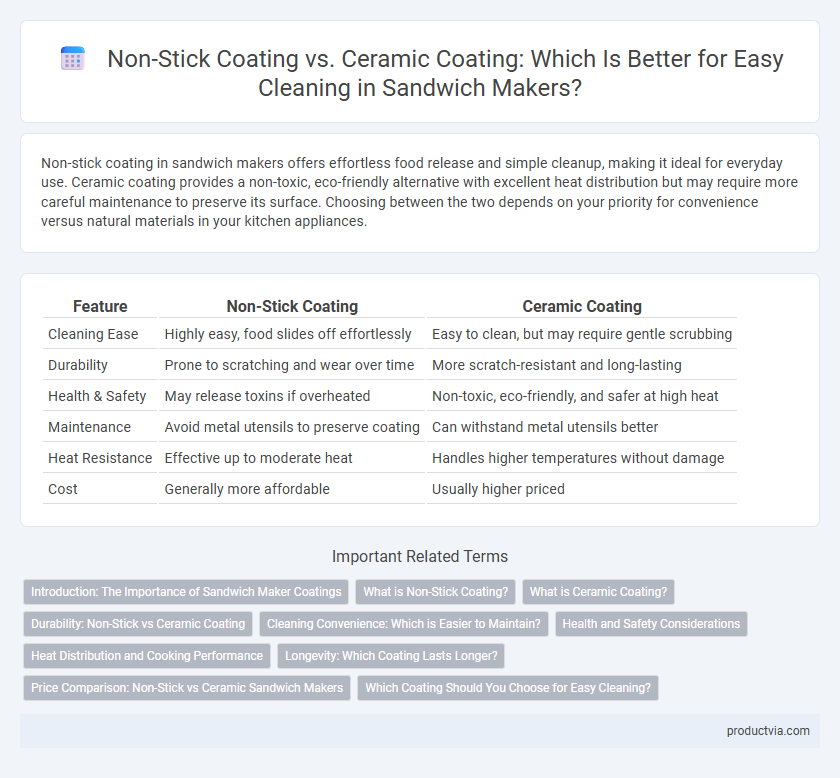Non-stick coating in sandwich makers offers effortless food release and simple cleanup, making it ideal for everyday use. Ceramic coating provides a non-toxic, eco-friendly alternative with excellent heat distribution but may require more careful maintenance to preserve its surface. Choosing between the two depends on your priority for convenience versus natural materials in your kitchen appliances.
Table of Comparison
| Feature | Non-Stick Coating | Ceramic Coating |
|---|---|---|
| Cleaning Ease | Highly easy, food slides off effortlessly | Easy to clean, but may require gentle scrubbing |
| Durability | Prone to scratching and wear over time | More scratch-resistant and long-lasting |
| Health & Safety | May release toxins if overheated | Non-toxic, eco-friendly, and safer at high heat |
| Maintenance | Avoid metal utensils to preserve coating | Can withstand metal utensils better |
| Heat Resistance | Effective up to moderate heat | Handles higher temperatures without damage |
| Cost | Generally more affordable | Usually higher priced |
Introduction: The Importance of Sandwich Maker Coatings
Non-stick coatings on sandwich makers provide a smooth surface that prevents food from sticking, making cleanup quick and effortless. Ceramic coatings offer a durable, chemical-free alternative that resists scratches and withstands higher temperatures while maintaining easy food release. Choosing the right coating enhances the longevity of the appliance and significantly simplifies maintenance.
What is Non-Stick Coating?
Non-stick coating in sandwich makers is typically made from polytetrafluoroethylene (PTFE), providing a smooth surface that prevents food from sticking and allows for effortless cleaning. This coating ensures that sandwiches cook evenly without burning or sticking, reducing cleanup time significantly compared to traditional metal surfaces. Unlike ceramic coatings, non-stick coatings generally offer superior non-stick performance but may have a shorter lifespan under high-temperature use.
What is Ceramic Coating?
Ceramic coating on sandwich makers is a non-toxic, eco-friendly layer made from inorganic materials that provide a smooth, non-stick surface, allowing for effortless food release and easy cleaning. Unlike traditional non-stick coatings, ceramic coatings resist high temperatures and abrasion without releasing harmful chemicals. This durable, scratch-resistant surface not only extends the appliance's lifespan but also simplifies maintenance by preventing food residue buildup.
Durability: Non-Stick vs Ceramic Coating
Non-stick coatings typically offer excellent initial non-stick performance but may degrade faster due to scratching and high heat exposure, reducing their durability over time. Ceramic coatings provide superior heat resistance and scratch durability, maintaining their easy-to-clean surface longer while being free of harmful chemicals. Choosing ceramic-coated sandwich makers often results in a longer-lasting, low-maintenance appliance with sustained non-stick properties.
Cleaning Convenience: Which is Easier to Maintain?
Non-stick coating in sandwich makers offers superior cleaning convenience due to its smooth surface that prevents food from sticking, allowing for quick and effortless wiping after use. Ceramic coating, while also non-stick, tends to be more durable and resistant to scratches but may require gentle cleaning to maintain its effectiveness over time. Choosing between non-stick and ceramic coatings depends on prioritizing immediate ease of cleaning versus long-term durability and maintenance.
Health and Safety Considerations
Non-stick coatings typically contain PTFE, which can release harmful fumes if overheated, posing health risks, whereas ceramic coatings are free from PTFE and PFOA, making them a safer option for health-conscious users. Ceramic coatings resist scratching and often allow easier cleaning without abrasive tools, reducing the risk of ingesting coating particles. Choosing ceramic enhances safety during cooking and simplifies maintenance, contributing to a healthier sandwich-making experience.
Heat Distribution and Cooking Performance
Non-stick coating in sandwich makers offers superior heat distribution for consistent cooking and prevents food from sticking, ensuring effortless cleaning. Ceramic coating provides a comparable non-stick surface with enhanced durability and better resistance to high temperatures, promoting even heat dispersion. Both coatings improve cooking performance, but ceramic coating often results in longer-lasting, easy-to-clean surfaces ideal for frequent use.
Longevity: Which Coating Lasts Longer?
Non-stick coatings on sandwich makers typically offer smooth food release but may degrade faster due to scratching and high heat exposure. Ceramic coatings provide enhanced durability and resist abrasion better, often maintaining their non-stick properties longer under regular use. For longevity, ceramic coatings generally outperform traditional non-stick surfaces, making them a preferred choice for extended appliance life.
Price Comparison: Non-Stick vs Ceramic Sandwich Makers
Non-stick sandwich makers typically come at a lower price point compared to ceramic-coated models, making them more budget-friendly for everyday use. Ceramic coating offers a chemical-free, eco-friendly surface but often comes with a higher initial cost due to its durability and heat resistance. Consumers seeking affordable options prioritize non-stick models, while those valuing longevity and health benefits may invest in pricier ceramic sandwich makers.
Which Coating Should You Choose for Easy Cleaning?
Non-stick coating offers superior ease of cleaning due to its smooth, slick surface that prevents food from sticking, making wiping off residues quick and effortless. Ceramic coating provides a natural, chemical-free alternative with a durable, scratch-resistant surface, but it may require more careful maintenance to maintain its non-stick properties over time. For hassle-free cleanup and minimal scrubbing, non-stick coating is generally the preferred choice in sandwich makers designed for easy cleaning.
Non-stick coating vs ceramic coating for easy cleaning Infographic

 productvia.com
productvia.com